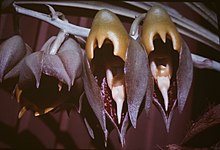Catasetum
| Catasetum | ||||||||||||
|---|---|---|---|---|---|---|---|---|---|---|---|---|

Catasetum pileatum |
||||||||||||
| Systematics | ||||||||||||
|
||||||||||||
| Scientific name | ||||||||||||
| Catasetum | ||||||||||||
| Rich. ex Kunth |
The genus Catasetum from the family of the orchid (Orchidaceae) comprises about 150 species of plants , all in Central and South America occur. According to R. Govaerts (as of 2020) there are even 190 species. The plants usually grow epiphytically . It is one of the few orchid genera whose species are dioecious . They are occasionally cultivated because of their interesting flowers .
description
All species of this genus form pseudobulbs on a creeping rhizome at a short distance . They consist of several internodes and are elongated oval shaped. The leaves are distributed in two rows on the pseudobulbs . They are oval, folded along the numerous visible leaf veins, tapering at the base in a wedge shape with a separating tissue to the pseudobulb. The leaf base encloses the pseudobulb in a tubular shape. The leaves are shed at the end of the growing season, usually due to a dry season.
Per pseudobulb there can be one or more inflorescences , they appear laterally from the leaf axils at the base of the pseudobulbs. The species of the genus Catasetum form male and female flowers, hermaphrodite flowers rarely occur. The differently sexed flowers look different within a species ( sexual dimorphism ), inflorescences with male flowers have more flowers than those with female ones. The male flowers are resupinated or not, all the petals are fleshy or waxy thick, the lip often bent over the flower like a cap. The column is elongated with the stamen at the end . It contains two pollinia , which are connected by an elastic stalk with a large adhesive disc (Viscidium). Starting from Rostellum (a converted scars -fabric) project two thread-like appendage inside of the column into the bloom. Female flowers are never resupinated, the lip is always helmet-shaped, the column is shorter and thicker, the stamen is only rudimentary and the appendages are missing.
The species of the genus Catasetum are pollinated by male splendor bees (Euglossini). If a bee touches the appendages of the pillar, the pollinia are actively thrown out and stuck to the insect. The magnificence bees that have been hit then avoid male flowers, but since the female ones look different, they continue to be visited. The placement of the pollinia on the beauty bee's body is very specific, so that when the female flower is visited, the pollinium meets the stigma.
distribution
The species of the genus Catasetum occur in Central and South America. From Mexico to the south they colonize the northern half of South America, in the south the distribution extends to Paraguay, Argentina and Bolivia. They grow there as epiphytes, often in the trunk area of dead trees. Altitudes from 0 to 1000 meters are populated.
Systematics
Within the subfamily Epidendroideae , the genus Catasetum is classified in the subtribe Catasetinae . This consists of a few other genera: Clowesia , Cycnoches , Dressleria and Mormodes . Dressler classifies them in the tribe Cymbidiae , but notes that they are cladistically a subgroup, not a sister group, of the subtribe Cyrtopodiinae . A list of the species and their range can be found at WCSP.
Culture
Due to the large, interesting flowers, the plants can be found in culture. They need plenty of light, water, and fertilizer during the growing season. Due to the growth rhythm, a drying time must be observed.
literature
- CH Dodson, CA Luer: Orchidaceae part 2 (Aa-Cyrtidiorchis) . Flora of Ecuador. Vol. 76. Botanical Institute, Göteborg 2005, pp. 166ff. ISBN 91-88896-51-X
- Robert L. Dressler: Phylogeny and Classification of the Orchid Family. University Press, Cambridge 1993, p. 168. ISBN 0-521-45058-6
- Jürgen Röth: Orchids . Deutscher Landwirtschaftsverlag, Berlin / Melsungen 1983, pp. 149f. ISBN 3-7888-0373-8
Individual evidence
- ↑ a b Rafaël Govaerts (Ed.): Catasetum. In: World Checklist of Selected Plant Families (WCSP) - The Board of Trustees of the Royal Botanic Gardens, Kew . Retrieved April 6, 2020.
Web links
- The Kew Gardens World Checklist of Catasetum lists all species and synonyms.
- Photo of Catasetum barbatum with female flowers
- Photo of Catasetum barbatum with male flowers
- Botanical Garden Munich: Catasetum image database

